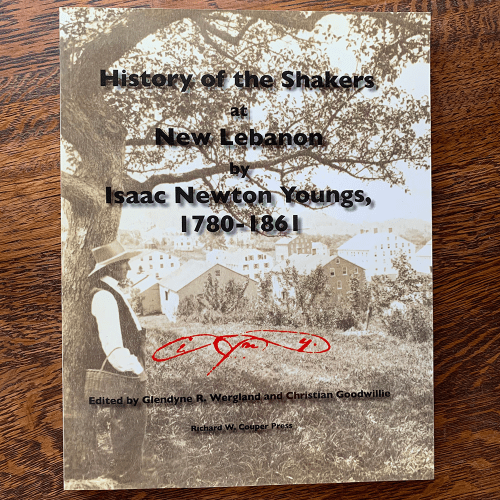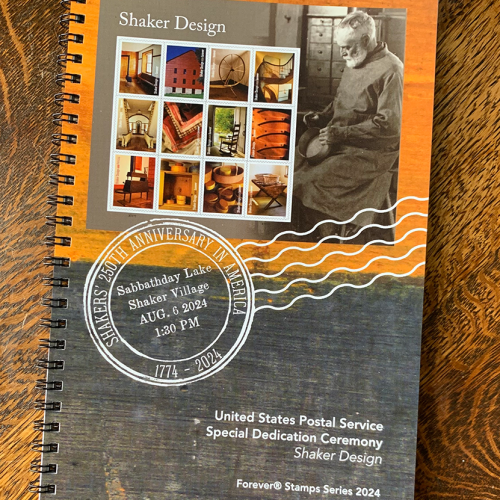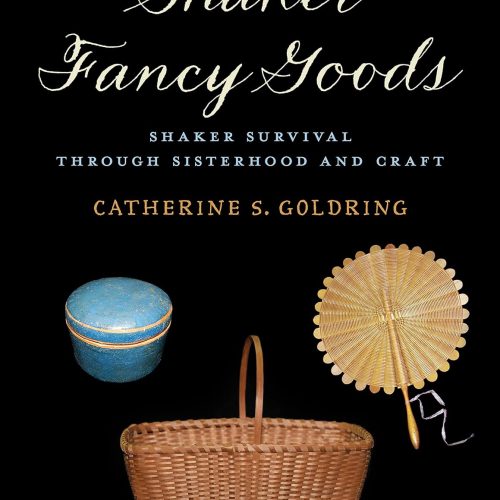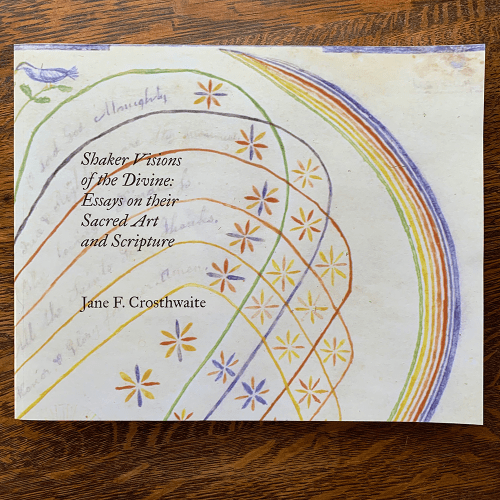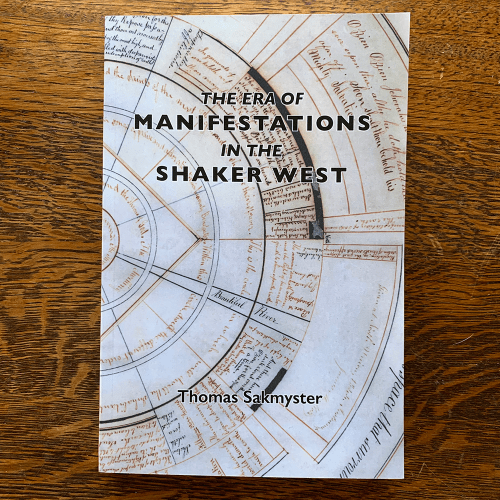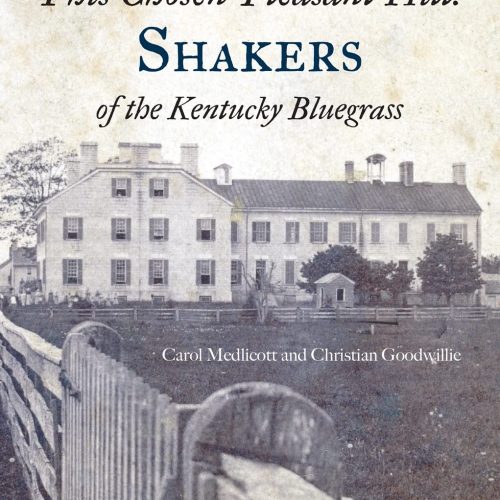Books about the Shakers
-
An Honorable Harvest: Shakers and the Natural World by Dr. Carl Benton Straub A 166 page soft covered book on the story of how religious movements initiated in Europe became American through taking seriously the land. In the Shaker ways of looking at the world, there is a basic religious unity between what is going on in history - "in the course of human events" - and what is at work in nature. The essential Shaker response to the land and the varied communities of life entwined with the land - wild and domestic - is the translation through interpretation and labor of nature's variables into patterns of meaning which reflect Shaker interest in religious community. Shaker Press, 2009. Soft covered, 166 pages.
-
EDITED BY GLENDYNE R. WERGLAND AND CHRISTIAN GOODWILLIE Shaker Brother Isaac Newton Youngs served his community at New Lebanon, New York, as a tailor, clockmaker, mapmaker, mechanic, inventor, musician and hymn writer, lens-grinder, stonecutter, button maker, bookkeeper, journalist, tinsmith, printer, pipe fitter, joiner, and blacksmith. He built a sundial, made tools including a weaver’s reed, turned clothespins, made knitting needles, and laid floors. He was also an architect and roofer. Few aspects of life at New Lebanon were outside of Youngs’s sphere of activity. Therefore, it is fitting that he undertook to write a comprehensive history of his community, systematically treating all facets of Shaker life and culture. Youngs’s A Concise View Of the Church of God and of Christ, On Earth is printed here for the first time in unabridged form. The editors have carefully transcribed and annotated the text, and have selected illustrations to complement Youngs’s descriptive text. Additionally, appendices supplying vital statistics, and information on the occupations of New Lebanon Shakers (many of which were compiled by Youngs) are included. Finally, a selection of Youngs’s poetry rounds out a rich portrait of the lives and talents of Brother Isaac Newton Youngs, and his beloved Shaker brethren and sisters, as they labored humbly in the creation of a unique world where work was worship, and heaven was all around them. Shaker Studies, no. 12. 277 pages, 2017. ISBN: 978-1-937370-22-0 Couper Press Paperback
-
Imagining the Shakers by Robert P. Emlen In the half century between 1830 and 1880 the visual culture of America's oldest, largest, and most distinctive communal religious society was portrayed in scores of printed images published in the popular illustrated press. In this complement to his 1987 book Shaker Village Views , Robert P. Emlen identifies and explicates every known engraving or lithograph that pictured the Shakers in the years of their greatest prosperity and before photography became popular in Shaker communities. Many of these images are reproduced here for the first time. Couper Press, Shaker Studies, no. 15. 338 pages, full color illustrations, 2019. ISBN: 978-1-937370-28-2
-
Like the Willow Tree The Diary of Lydia Amelia Pierce, Portland, Maine, 1918 by Lois Lowry Historical fiction, recommended for grades 3-8 and a favorite recommendation of ours to all children visiting Sabbathday Lake. In 1918, as the Great War rages in Europe, the Spanish influenza tears a brutal path across the United States, leaving devastation in its wake. Ordinary life is turned upside down as schools are closed, and all spheres of public life are shut down. Suddenly, eleven-year-old Lydia Pierce and her older brother, Daniel, find themselves orphans of the flu, and are taken by their grieving uncle to be raised in the Shaker community at Sabbathday Lake. Thrust into the Shaker's unfamiliar way of life, Lydia, a fiercely independent girl, must grapple with a new world that is nothing like the one she used to know. Lydia must work hard, and all the while she worries about her headstrong brother, who has run away. In time, and with her courageous spirit, Lydia learns to overcome the devastation wrought by the Spanish flu pandemic and find the joy in living with the Shakers -- yet she cannot stop wondering, will Daniel ever return? Newbery medalist Lois Lowry's poignant story of a girl living through the Spanish Influenza pandemic sadly seems more resonant than ever before. In the face of COVID-19, readers are sure to draw comfort from Lydia's sense of hopefulness. Now, with a brand new introduction from the author! Scholastic 224 pages paperback ISBN 9781338724325
-
A Journey of Discovery by Martha Boyce, Dale Covington, and Richard Spence A collection of maps, histories, and general information of better known and lesser known Shaker sites in Kentucky, Ohio, Indiana, Illinois, and Michigan beginning in 1800. Knot Garden Press, 140 pages, paperback ISBN: 978-0965501811
-
Honoring the 250th anniversary of the Shakers' arrival in America and their enduring influence, and the United States Postal Service releasing the Shaker Design commemorative stamp sheet. This spiral-bound 9" x 6" book is printed full-color and is a limited-edition printing designed and published by The United Society of Shakers. Includes never-before published historic photographs to illustrate the following chapters: -Official Stamp Brief, illustrated by Michael Graham with items from our collection -A Photoessay of Shaker Village, Sabbathday Lake, Maine by Michael Freeman (for 1987's Shaker Life, Work, and Art) -The Shakers and Their Post Office by Michael S. Graham, presenting research by Nancy L. George -A Brief History of the Post Office, Sabbathday Lake, Maine by Sister Eleanor M. Philbrook (for the Shaker Quarterly Spring 1964) 84 pages. Published July 2024, United Society of Shakers.
-
Shaker Fancy Goods: Shaker Survival Through Sisterhood and Craft by Catherine Goldring Shaker Fancy Goods tells the story of the Shaker Sisters of the nineteenth and early twentieth century who responded to the economic perils of the Industrial Revolution by inventing a lucrative industry of their own—Fancy Goods, a Victorian term for small adorned household objects made by women for women. Thanks to their work ethic, business savvy, and creativity, the tireless Shaker Sisters turned a seemingly modest trade into the economic engine that sustained their communal way of life, just as the men were abandoning the sect for worldly employment. Relying on journals and church family records that give voice to the plainspoken accounts of the sisters themselves, the book traces the work they did to establish their principal revenue streams, from designing the products, to producing them by hand (and later by machine, when they could do so without compromising quality) to bringing their handcrafts to market. Photographs, painstakingly gathered over years of research from museums and private collections, present the best examples of these fancy goods. Fancy goods include the most modest and domestic of items, like the pen wipes that the Sisters shaped into objects such as dolls, mittens, and flowers; or the emeries, pincushions, and needle books lovingly made back in an era when more than a minimal competency in sewing was expected in women; to more substantial purchases like the Dorothy cloaks that were in demand among fashionable women of the world; or the heavy rib-knitted sweaters, cardigans, and pullovers that became popular items among college boys and adventurous women. Hardcover, 192 pages, color Downeast Books 2022 978-1684750238
-
Shaker Inspiration: Five Decades of Fine Craftsmanship By Christian Becksvoort "I first met Chris Becksvoort some 40 years ago when I joined the Community. Here I found a man quite dedicated to his craft and hungering after more to allow him to better his craft. The friendship between Chris, his wife, Peggy, and our Community is one that is very dear to us. Chris continues to donate his time in giving workshops and helping with workdays and Peggy documents with her camera events and life here. We have been enriched and we are grateful for the Becksvoorts in our life." -Brother Arnold, Sabbathday Lake Shaker Community “Best known for his work in television comedy (Parks and Recreation episode “Ron and Diane”), Christian Becksvoort reveals a surprising amount of woodworking wisdom, culled from spending a mere lifetime singularly focused on his masterful furniture work, mostly Shaker-inspired, mostly in cherry. This book is an instant treasure.” -Nick Offerman, actor, author and woodworker Opinionated? Yes. Informative? Absolutely. Interesting and inspiring? You bet. Not too many woodworkers can claim five decades of business success, but Christian Becksvoort is among them. In “Shaker Inspiration,” he shares not only his woodworking knowledge and some of his best professional techniques for producing top-quality work, but also the business advice that helped him establish and sustain his long career in a one-man shop. Plus, he shares measured drawings for 13 of his own well-known furniture designs and seven Shaker pieces that he’s reproduced. Whether or not you, like Christian, are inspired by the Shaker tradition, you’re sure to be inspired by one of the best-known names in woodworking. “Shaker Inspiration” begins with information that all woodworkers need – the nitty gritty of how to successfully make trees into furniture. This requires a firm grasp of wood movement – one of Chris’s specialties – and he shares many of the tricks he uses to ensure his pieces remain sound through the seasons and generations. The lessons are both big and small, from the advantages to working with a single species to how to calculate how much a drawer front will move inside a house with forced-air heat. Every page of this section is filled with little shop tricks that Christian has used to become a productive woodworker, from how to remove dovetail waste to how to align a drawer front and drawer side perfectly when dovetailing. After all the great information on the technical side of things, Christian dives into discussing the business side of things. He pulls no punches in discussing the difficulties of life as a furniture maker and designer. Getting started, you do whatever it takes to pay the bills. We’ve all done our share of kitchens and built-ins, and replaced porch railings. After more than five decades, I can do the woodworking almost in the dark. It’s the business end that’s a constant challenge, and it keeps me on my toes. He offers straightforward advice on setting up your shop, from the roof to the heat pump to the sign you use to announce your business to customers. Even how to set up relationships with suppliers and subcontractors. It is a sobering section, but if you ever want to set up a woodworking business, it’s the type of information that is almost impossible to come by. Finally, “Shaker Inspiration” dazzles you with three sections of photos and measured drawings. The last 60-odd pages offer a collection of Christian’s original designs, reproductions of Shaker pieces he’s made (and made famous) and photos of the original Shaker pieces that have inspired him the most as a craftsman and a designer. In addition to a beautiful photo and details about the piece, Christian shares a construction drawing of each project that will allow intermediate woodworkers to produce their own version. “Shaker Inspiration” is 166 pages and produced entirely in the United States by Lost Art Press. The 8.5” x 11” full-color book is printed on heavy coated paper. The pages are sewn and glued for durability and covered in cotton-covered boards. A tear-resistant dust jacket completes the package.
-
by Jane F. Crosthwaite In the mid-nineteenth century, both Shaker sacred texts and gift drawings were rich with theological arguments for the millennial vision of a heaven celebrating the Heavenly Father and Holy Mother Wisdom and of a communal society embodying its teachings in celibacy and peace. This richly-illustrated, full color volume, explores these Shaker visions of the divine. Jane Freeman Crosthwaite first encountered the Shakers when preparing a course on women in American religious history for a class at Mount Holyoke College. Mother Ann Lee, her teachings, her followers, and their musical, scriptural, and artistic ventures in theological expression became the focus of numerous seminars, lectures, and articles in the years to follow. Most notably, she and Christian Goodwillie edited Millennial Praises: A Shaker Hymnal which brought together the early, theologically-rich hymn texts with the scattered musical records. Now retired from teaching courses in religion and ethics (and delivering a number of baccalaureate addresses), Professor Crosthwaite has tucked away a teaching award from Mount Holyoke, inclusion in The Princeton Review’s 300 Outstanding Teachers, a Distinguished Alumni Award from Wake Forest University, and an honorary Doctor of Humane Letters degree, from Queens University of Charlotte. Shaker Studies, no. 18. 242 pages, 2022. Couper Press Paperback ISBN: 978-1-937370-30-5
-
Shop Drawings of Shaker Furniture & Woodenware (Vols, 1, 2 & 3) by Ejner Handberg An authoritative and classic three-book collection, now in one volume. Together in one comprehensive book for the first time, these three volumes of Shop Drawings of Shaker Furniture & Woodenware capture the simplicity, precision, and utility of shaker craftsmanship. In print for more than 20 years, these legendary and authoritative volumes have served as guides for cabinetmakers and antique collectors worldwide. Includes shop drawings for more than 100 authentic pieces. 200 black-and-white illustrations. Hardcover, 280 pages, Countryman Press, October 2007
-
The Architecture of the Shakers by Julie Nicoletta, photography by Bret Morgan, foreword by Robert Emlen From Maine to Kentucky, the Shakers built communal villages whose unique buildings were designed to accommodate hundreds of inhabitants unified in the common purpose of work and worship. Julie Nicoletta's perceptive text and Bret Morgan's striking photographs illuminate the austere beauty, regional variations, and functional and stylistic evolution of Shaker buildings over the course of two centuries, evoking a visual and literary survey of Shaker design and its impact on our culture at large. Architects, designers, curators, collectors, and an ever-widening public have sought inspiration in Shaker art and architecture. The Architecture of the Shakers is a book for all those who wish to learn more about these remarkable buildings and how the rich cultural legacy of the Shakers continues to resonate within them. Hardcover, 179 pages, Countryman Press, June 2000
-
by Thomas Sakmyster This study—the first of of its kind— is a comprehensive examination of one of the most fascinating and colorful periods of American religious history: the Shakers’ Era of Manifestations. Based on a comprehensive reading of primary sources from Shaker communities in Ohio and Kentucky, this volume documents the spiritual highs and lows promulgated by Shaker visionists (spirit mediums) as their gifts impacted their communities in a variety of ways —both positive and negative. Visits from Mother Ann Lee, Holy Mother Wisdom, the Eternal Father, and the Holy Savior (Jesus) are detailed herein, as well as the establishment of outdoor worship sites—Feast Grounds—the reception of gift songs, new dances, and most intriguing of all, interactions with the departed of many races and nations, including an exceptional series of encounters with Indigenous American (Indian) spirits, historical figures like George Washington, and many Shaker founders. Thomas Sakmyster is an emeritus professor at the University of Cincinnati, where he was the Walter Langsam Professor of Modern European History. He has published widely on his areas of specialization, including modern East European history, the American Communist Party, world communism, and Shaker history. He is co-editor of The Shakers of White Water, 1823-1916 and author of The Last Shaker Apostate: Augustus Wager and Union Village, Ohio and articles on various themes in the history of the Shakers. Shaker Studies, no 19, 339 pages, 2024. ISBN: 978-1-937370-40-4 Couper Press Paperback
-
The Shaker Legacy: Perspectives on an Enduring Furniture Style by Christian Becksvoort, photographs by John Sheldon Solid construction and honest functionality make Shaker furniture one of the most popular and timeless design categories. Based on extensive research and personal experience with the Sabbathday Lake Shaker Community, this book traces the roots of Shaker design to Shaker belief, which inspired the clean lines, careful craftsmanship, and signature details that define the style. Chris also discusses the less known Victorian period of Shaker design and shows how this style has influenced subsequent ones. A bibliography, glossary, and index are included. Chris Becksvoort is a long-time friend and neighbor of the Community and teaches wood working workshops with us each season. Hardcover, 240 pages, full color. Taunton Press, 2000.
-
The Shakers of Enfield, Connecticut 1780-1968 by Stephen J. Paterwic The Shaker community at Enfield, Connecticut, lasted from 1792 to 1914. Shaker founder Mother Ann Lee gathered converts there, and her successor Father Joseph Whittaker ministered to them before he died there in 1787. This is the first book devoted to telling the 130-year story of this relatively unknown celibate Christian community. Additionally, eighteen appendices provide rich primary source information for further research. Couper Press, Shaker Studies, no. 16. Thick book, approx. 550 pages, 2020. ISBN: 978-1-937370-29-9
-
The Shakers: From Mount Lebanon to the World Edited by Michael K. Komanecky, Contribution by Stephen J. Stein, Jerry V. Grant, Michael S. Graham and Brother Arnold Hadd An important book on Shaker art and life, offering a fresh look at a style that has endured through centuries and continues to inspire designers and homeowners. This book presents the elegantly austere and simply styled objects of the Shakers in the context of their faith and community at Mount Lebanon, N.Y., the spiritual and administrative center of the Shaker world. Outstanding examples of furniture, textiles, tools, and other objects-drawn primarily from the collection of Shaker Museum | Mount Lebanon-bring the fascinating world of the Shakers to life. The book also explores the equally compelling material culture of Sabbathday Lake in New Gloucester, Maine, the last active Shaker community, and how this group of Shakers continued to thrive while other Shaker communities elsewhere gradually disappeared. Accompanying a major exhibition organized by the Farnsworth Art Museum, this book presents a new and authentic perspective on the Shaker community. Specially commissioned photography, archival imagery, essays by prominent scholars, and a firsthand interview with a member of the Sabbathday Lake Shaker community deepen our understanding of this influential movement and style. About the Authors: Michael K. Komanecky is chief curator at the Farnsworth Art Museum, in Rockland, Maine. Stephen J. Stein is a historian of American religion at the University of Indiana. Jerry V. Grant is the director of research and library services at the Shaker Museum. Michael S. Graham is the director of the Sabbathday Lake Shaker Village. Brother Arnold Hadd is a member of the Sabbathday Lake Shaker Community. Reviews "The fascinating story of the Shakers, and of their extraordinary furniture, is now told in The Shakers: From Mount Lebanon to the World. This book expands our knowledge by documenting other types of practical furniture, tools and even Shaker clothing...this beautiful and enthralling book opens a window onto the world of the Shakers..." -Wall Street Journal "...this enlightening, visually arresting...uplifting exhibition highlights American ingenuity, resilience and fearlessness; its can-do spirit and individualism. The show is a rich overview of the Shaker community; but it celebrates individual artists, expressing themselves through a plain-spoken poetry that is uniquely American." -Review of Exhibition by the Wall Street Journal "With simple objects, simple words, Farnsworth tells complex Shaker story...it is a great exhibition. It is beautifully installed and fascinating. The objects are important and compelling. The language behind the installation is the level-headed and eminently commonsensical voice of the Believers." -Review of Exhibition by the Portland Press Herald "...the show will present a comprehensive look at the religious, social and economic foundations of Shaker life, seen through Shaker-made objects…accompanied by a richly illustrated book…” –The Republican Journal Hardcover, 256 pages, full color, 9.5" x 11". Skira Rizzoli; First Edition edition (July 1, 2014)
-
The Story of the Shakers by Flo Morse The Story of the Shakers by Flo Morse offers a stimulating, graceful summary of Shaker beliefs and the way of life that still endures. Flo, a former writer for the New York Herald Tribune, is the author of The Shakers and the World's People, a comprehensive, widely praised documentary history. Revised edition, February 2016, Paperback, 128 pages, Countryman Press.
-
By Carol Medlicott and Christian Goodwillie The United Society of Believers in Christ’s Second Appearing, commonly called “Shakers,” created a thriving community in the Kentucky Bluegrass beginning soon after 1805. Located near the high palisades over the Kentucky River in Mercer County, Pleasant Hill prospered for over a century, an example of religious devotion made manifest in a setting of architectural and agricultural beauty. Shaker life at Pleasant Hill had many facets, both spiritual and temporal. This meticulously researched and richly illustrated volume presents a fresh exploration of many aspects of life at Pleasant Hill, ranging from the site’s natural setting and its historical and spiritual underpinnings, to the community’s complex ethnic, racial, and gender dynamics, and its plentiful domestic economy. Carol Medlicott is a historical geographer in the Department of History at Northern Kentucky University. Her work considers various aspects of the western Shaker experience and of early Shaker expansion, including settlement patterns, leadership, cultural interaction, cartography, and music. Her major books addressing the Shaker west are Issachar A Shaker's Journey (University Press of New England, 2013) and Richard McNemar and the Music of the Shaker West (co-authored with Christian Goodwillie, Kent State University Press, 2013). Christian Goodwillie is director and curator of special collections and archives in the Burke Library at Hamilton College in Clinton, New York. He has served as the president of the Communal Studies Association and was honored with their Distinguished Scholar Award in 2021. Goodwillie has authored, co-authored, or edited, twelve books on the Shakers and Freemasonry, as well as publishing numerous articles. Both are good friends of Sabbathday Lake Shaker Village and have presented lectures with us. Publisher: Straggling Trembler Press (January 1, 2022) Perfect Paperback: 291 pages ISBN-13: 979-8987033401
-
The A to Z of the Shakers by Stephen J. Paterwic The United Society of Believers in Christ's Second Appearing, commonly known as the Shakers, followed Mother Ann Lee to the United States in 1774 when life in England became difficult. In the United States, they established several colonies whose governing principals included celibacy and agrarian communal living. Even at its peak, however, Shakerism claimed only about 4,500 members. Today, except for one active community in Sabbathday, Maine (that's us!), the great Shaker villages are diminished, but the Shakers left an enduring impact on the religion and culture of the United States. The A to Z of the Shakers relates the history of this fascinating group through a chronology, an introductory essay, a bibliography, and over 200 cross-referenced dictionary entries on Shaker communities, industries, individual families, and important people. Every definition, biography, and point of history was submitted to the Shakers at Sabbathday Lake for their review before it was included for publication. As such, the voice of the contemporary Shakers is found in the dictionary, and they have given it their unequivocal endorsement. Paperback, 370 pages. Scarecrow Press
-
by Michael Volmer Located thirty miles west of Boston, the town of Harvard was incorporated in 1732. With vintage photographs, some of which date from the 1860s, Harvard reflects on eighteenth- and nineteenth-century life, as well as the numerous political and spiritual philosophies that shaped the town. Shown are the Harvard Shaker community, the Alcotts' transcendentalist commune called Fruitlands, and Clara Endicott Sears, founder of Fruitlands Museums. Nostalgic scenes from the collection of local photographer William Wright capture an era of parades and picnics and community spirit. Arcadia Publishing, 128 pages.
-
By Thomas P. Blake and the New Gloucester Historical Society Named by the proprietors from Gloucester, Massachusetts, New Gloucester began as a frontier town, as it was the most inland settlement in Maine at the time. Incorporated in 1774, the town has been called home by such notables as mapmaker and author Moses Greenleaf, artist D. D. Coombs, original proprietor of the town of Foxcroft Joseph E. Foxcroft, traveling minister Ephraim Stinchfield, Abraham Lincoln's secretary of treasury William Pitt Fessenden, and abolitionist Samuel Fessenden. Shaker societies were set up in nine states, but the Sabbathday Lake Society, founded in 1783, is now the only active Shaker community remaining. With a long history of lumber mills and farms, New Gloucester is also home to Pineland Farms, the former site of the Maine Home for the Feeble-Minded, established in 1908, and now a renovated 19-building campus and 5,000-acre working farm. Arcadia Publishing, 128 pages.
-
By Bruce T. Marshall Shaker Heights achieved international renown in the early 20th century as an enclave for wealthy residents—a city of stunning homes, substantial green space, an excellent school system, and attentive municipal services. Cleveland entrepreneurs O. P. and M. J. Van Sweringen established Shaker Heights as a haven from the stresses of city life and claimed a connection with previous residents of this land, the North Union settlement of Shakers. Shaker communities sought to create paradise on earth by living communally and focusing on the life of the spirit. Buyers in Shaker Heights were assured that their paradise would last forever because of restrictions on what could be built and who could live there. Nevertheless, Shaker Heights has changed from a protected environment for the wealthy to a stable, integrated city that intentionally promotes diversity in its population. This is a remarkable story of dramatic change but also continuity as residents pursue the goal of creating an ideal community. Arcadia Publishing, 128 pages.
-
By James W. Hooper, Forewords by Larrie Curry of Pleasant Hill and Tommy Hines of South Union The Shaker Communities of Kentucky: Pleasant Hill and South Union presents the lives, struggles, and achievements of a remarkable people. The chronicle spans Shaker beginnings in England and relocation to America, the Great Awakening in America followed by the Kentucky Revival, Shaker beginnings in Kentucky, and the establishment of the South Union and Pleasant Hill Shaker villages. The Shaker central ministry sent missionaries to Kentucky from New York in 1805 after hearing about the Kentucky Revival, which culminated with the Cane Ridge Revival of 1801. Their efforts resulted in the establishment of villages in Kentucky, Ohio, and Indiana. Pleasant Hill and South Union were among the most successful and enduring of all the Shaker villages. This volume provides a striking visual portrayal of Shaker life by means of rare vintage images, including beliefs and worship, relationships with other believers and "the world," and their highly regarded workmanship. Gradual decline resulted in the closing of both villages, but restorations have turned both sites into popular destinations. Arcadia Publishing, 148 pages.
-
By Cheryl Bauer Founded in 1805, Union Village began as a religious and communal experiment. Eventually it became one of America's largest and most productive Shaker communities, its members achieving many firsts in education, equality, music, horticulture, and animal husbandry. Their unique faith influenced every aspect of their lives, from making furniture to raising children. They welcomed the leading figures of the period, including Native American chiefs, politicians, and abolitionists, while they continued to open other Shaker settlements in Ohio, Kentucky, Indiana, and Georgia. These vintage images—including many never published before—trace the Shakers' progress as they worked toward creating an earthly paradise. Although Union Village dissolved in 1912, some Shakers remained there for almost another decade. Today Union Village's heritage is still shared with the public at OtterbeinLebanon Retirement Community and in neighboring Lebanon. Arcadia Publishing, 128 pages.
-
by Stephen Paterwic A compilation of essays and statistical information on the Tyringham Shakers, by one the leading scholars on that Community. It is the largest compilation of information on Tyringham in one source. It includes a series of rare of photographs of the Village. Couper Press, Shaker Studies, no. 6. 142 pages, illustrations, 2013.



